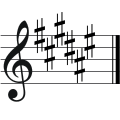D-sharp minor
D sharp minor is a key of the tonal family minor, which is built on the root note D sharp. The key of D sharp minor is written in musical notation with six sharps (F sharp, C sharp, G sharp, D sharp, A sharp, E sharp). The corresponding scale and the fundamental chord of this key (the tonic D sharp - F sharp - A sharp) are also designated by the term D sharp minor.

![]()
![]()
![]()
![]()
![]()
![]()
![]()
![]()
![]()
![]()
![]()
![]()
![]()
![]()
![]()
Works
Classical music:
- Alexander Scriabin: Etude in D flat minor op. 8 No. 12
- Erik Satie: Trois Sarabandes (No. 2)
Pop music:
- Dead Man's Party - Oingo Boingo
Key classification
| Keys and their accidentals | |||||||||||||||
| Portent: | 7 ♭ | 6 ♭ | 5 ♭ | 4 ♭ | 3 ♭ | 2 ♭ | 1 ♭ | 0 ♭/♯ | 1 ♯ | 2 ♯ | 3 ♯ | 4 ♯ | 5 ♯ | 6 ♯ | 7 ♯ |
| Major keys: | Ces | Ges | Des | As | It | B | F | C | G | D | A | E | H | F# | C sharp |
| Minor keys: | as | it | b | f | c | g | d | a | e | h | F# | cis | gis | dis | ais |
Questions and Answers
Q: What is D-sharp minor?
A: D-sharp minor is a minor scale based on D♯. It has six sharps in its key signature and its enharmonic equivalent is E-flat minor.
Q: What is the relative major of D-sharp minor?
A: The relative major of D-sharp minor is F-sharp major.
Q: What is the parallel major of D-sharp minor?
A: The parallel major of D-sharp minor is usually replaced by E-flat major because D-sharp major's two double sharps make it impractical to use.
Q: Why does Bach write the eighth prelude in E flat Minor but the accompanying fugue in D sharp Minor?
A: Bach chose to write the eighth prelude in E flat Minor but the accompanying fugue in D sharp Minor because music written in this key was considered very difficult to read, so little music was written mainly in this key during the Classical era.
Q: Who wrote Etude Op 8 No 12?
A: Etude Op 8 No 12 was written by Russian composer Scriabin.
Q: How many pieces did Lyapunov compose using either version of this key signature?
A: Lyapunov composed three pieces using either version of this key signature - his second etude from his Op 11 set, Variations on a Russian Theme, Op 49, and Piano Concerto No 1, Op 4.
Q: How should wind instruments be notated if they are playing music written for piano in this key signature?
A: If wind instruments are playing music written for piano in this key signature, their parts should be written in F minor rather than E sharp minor.
Search within the encyclopedia














